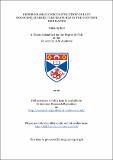Files in this item
Dendroclimatic reconstruction of late Holocene summer temperatures in the Scottish Highlands
Item metadata
| dc.contributor.advisor | Wilson, Rob | |
| dc.contributor.author | Rydval, Miloš | |
| dc.coverage.spatial | 219 | en_US |
| dc.date.accessioned | 2016-03-14T16:16:34Z | |
| dc.date.available | 2016-03-14T16:16:34Z | |
| dc.date.issued | 2016-06-22 | |
| dc.identifier.uri | https://hdl.handle.net/10023/8418 | |
| dc.description.abstract | This thesis focuses on reconstructing past temperatures using Scots pine (Pinus sylvestris L.) tree-ring chronologies developed from Scotland. The research aims to fill a spatial and temporal gap in understanding northwest European climate dynamics, thus providing the context for assessing future climate changes in this region. Development of both a spatially complete reconstruction from an extensive network of 44 'living' Scottish tree-ring chronologies for the last few centuries, but also a near-millennium length chronology from central Scotland using mainly lake-derived 'subfossil' wood material was undertaken. Before reconstruction development, a combination of treegrowth modelling and disturbance removal methodologies was utilised in order to understand the drivers of pine growth in the Scottish Highlands, and to assess and remove anthropogenic disturbance and other non-climatic influences on growth. The advantages and limitations of utilising the relatively new 'Blue Intensity' (BI) parameter was also explored and assessed, particularly in relation to its possible utilization as a more affordable surrogate for maximum latewood density in the development of temperature reconstructions and for crossdating validation of undated samples. Although BI showed much promise for dendroclimatology, elimination of low frequency biases resulting from sample discolouration still requires further attention. Chronologies from the Cairngorms in central Scotland were identified as most suitable for reconstruction development, while reconstructions based on chronologies from other areas in the west were found to be weaker due to a range of factors including disturbance. In order to maximise reconstruction strength, BI and ring width (RW) data were combined to produce composite high-frequency BI / low-frequency RW chronologies. Although it was possible to develop an ~800 year reconstruction of temperature from central Scotland, there is substantial potential to further extend this reconstruction back in time. | en_US |
| dc.language.iso | en | en_US |
| dc.publisher | University of St Andrews | en |
| dc.subject | Dendrochronology | en_US |
| dc.subject | Dendroclimatology | en_US |
| dc.subject | Palaeoclimatology | en_US |
| dc.subject | Temperature reconstruction | en_US |
| dc.subject | Tree rings | en_US |
| dc.subject | Scots pine | en_US |
| dc.subject | Scotland | en_US |
| dc.subject.lcc | QC884.5S3R8 | |
| dc.title | Dendroclimatic reconstruction of late Holocene summer temperatures in the Scottish Highlands | en_US |
| dc.type | Thesis | en_US |
| dc.contributor.sponsor | Carnegie Trust for the Universities of Scotland | en_US |
| dc.type.qualificationlevel | Doctoral | en_US |
| dc.type.qualificationname | PhD Doctor of Philosophy | en_US |
| dc.publisher.institution | The University of St Andrews | en_US |
This item appears in the following Collection(s)
Items in the St Andrews Research Repository are protected by copyright, with all rights reserved, unless otherwise indicated.

